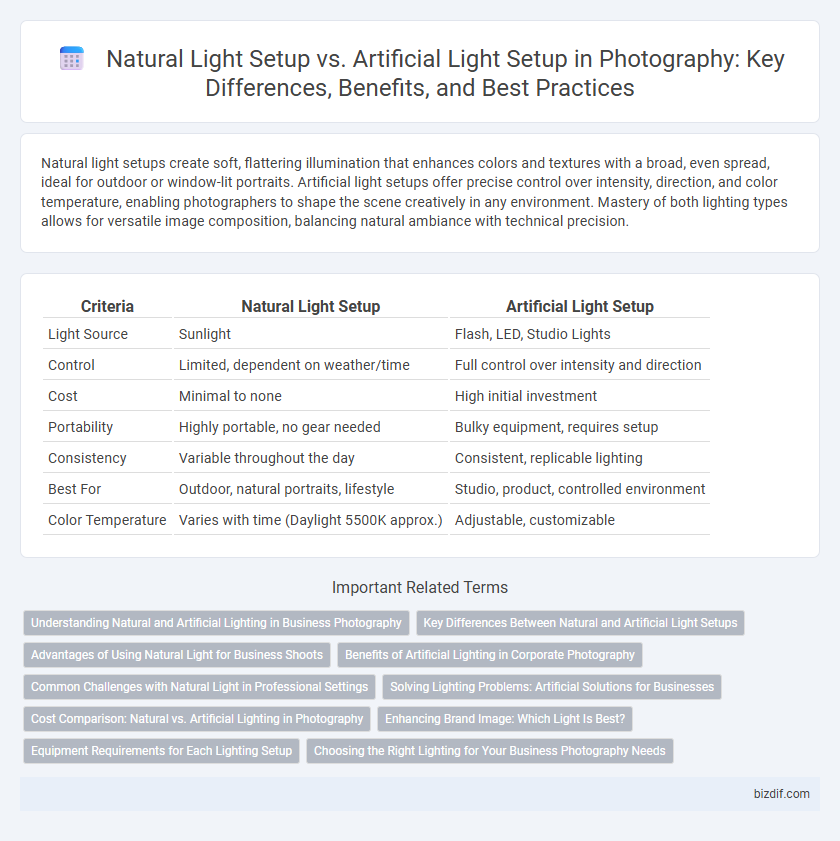Natural light setups create soft, flattering illumination that enhances colors and textures with a broad, even spread, ideal for outdoor or window-lit portraits. Artificial light setups offer precise control over intensity, direction, and color temperature, enabling photographers to shape the scene creatively in any environment. Mastery of both lighting types allows for versatile image composition, balancing natural ambiance with technical precision.
Table of Comparison
| Criteria | Natural Light Setup | Artificial Light Setup |
|---|---|---|
| Light Source | Sunlight | Flash, LED, Studio Lights |
| Control | Limited, dependent on weather/time | Full control over intensity and direction |
| Cost | Minimal to none | High initial investment |
| Portability | Highly portable, no gear needed | Bulky equipment, requires setup |
| Consistency | Variable throughout the day | Consistent, replicable lighting |
| Best For | Outdoor, natural portraits, lifestyle | Studio, product, controlled environment |
| Color Temperature | Varies with time (Daylight 5500K approx.) | Adjustable, customizable |
Understanding Natural and Artificial Lighting in Business Photography
Natural light setup in business photography utilizes sunlight to create soft, authentic illumination, enhancing skin tones and reducing harsh shadows, which is ideal for outdoor and window-lit portraits. Artificial light setup employs studio strobes, LED panels, or flash units, offering full control over intensity, direction, and color temperature, crucial for consistent branding and professional indoor shoots. Mastery of both lighting types enables photographers to adapt to varied business environments, ensuring high-quality, visually compelling images that align with client needs.
Key Differences Between Natural and Artificial Light Setups
Natural light setups utilize sunlight, offering a broad spectrum and soft diffusion that varies with time and weather conditions, creating dynamic and natural shadows. Artificial light setups employ controlled sources like LED panels, strobes, or flash units, providing consistent intensity and color temperature for precise lighting control. Key differences include variability, color accuracy, and flexibility, with natural light being cost-effective but unpredictable, while artificial light ensures repeatability and creative manipulation.
Advantages of Using Natural Light for Business Shoots
Natural light offers a cost-effective and easily accessible solution for business shoots, creating a soft, flattering effect that enhances product and skin tones naturally. Its dynamic qualities change throughout the day, providing versatile moods and atmospheres that can adapt to different branding needs. Utilizing natural light reduces the need for bulky equipment, allowing for quicker setups and a more organic, authentic aesthetic in corporate and commercial photography.
Benefits of Artificial Lighting in Corporate Photography
Artificial lighting in corporate photography offers precise control over light intensity, direction, and color temperature, ensuring consistent and professional results regardless of external conditions. It enables photographers to highlight facial features and branding elements effectively, enhancing image sharpness and brand identity. Controlled lighting minimizes shadows and reflections, producing polished visuals that convey professionalism and reliability.
Common Challenges with Natural Light in Professional Settings
Natural light in professional photography presents challenges such as inconsistent intensity and color temperature, which can affect image quality and require constant adjustments. Limited control over sunlight direction and shadows often results in unpredictable lighting patterns, impacting composition and exposure. Weather conditions and time of day further complicate maintaining consistent lighting, making artificial light setups a preferred option for reliability and precision.
Solving Lighting Problems: Artificial Solutions for Businesses
Artificial light setups provide precise control over intensity, color temperature, and direction, effectively solving inconsistent natural lighting problems in business photography. Businesses often rely on LED panels, softboxes, and ring lights to create a consistent atmosphere for product shoots, minimizing shadows and enhancing image clarity. These solutions ensure that lighting conditions remain stable regardless of time of day or weather, improving brand presentation and visual marketing outcomes.
Cost Comparison: Natural vs. Artificial Lighting in Photography
Natural light setups in photography typically involve minimal to no equipment investment, relying on sunlight which is free and readily available, making it a cost-effective choice for beginners and professionals alike. Artificial lighting setups, including strobes, continuous lights, and modifiers, require significant initial investment ranging from affordable basic kits around $100 to professional setups exceeding $2000, plus ongoing costs for maintenance and electricity. Balancing cost with creative control, photographers often choose natural light for budget-friendly shoots, while artificial lighting offers consistent, customizable illumination despite higher expenses.
Enhancing Brand Image: Which Light Is Best?
Natural light setup enhances brand image by providing a soft, authentic ambiance that resonates with audiences seeking genuineness and relatability. Artificial light setup offers precise control over intensity, color temperature, and direction, enabling consistent, polished visuals aligned with professional branding standards. Choosing between natural and artificial light depends on the brand's identity goals, target audience preferences, and the desired emotional impact conveyed through imagery.
Equipment Requirements for Each Lighting Setup
Natural light photography relies primarily on available sunlight, requiring minimal equipment such as reflectors, diffusers, and sometimes portable shades to manipulate light direction and intensity. Artificial light setups demand more complex gear, including various types of studio lights like strobes, continuous lights, softboxes, umbrellas, light stands, and power sources to control color temperature, diffusion, and shadow creation precisely. Understanding each setup's equipment needs helps photographers optimize lighting conditions for indoor and outdoor shoots, ensuring consistent image quality.
Choosing the Right Lighting for Your Business Photography Needs
Selecting the appropriate lighting for business photography hinges on the desired mood and style, with natural light offering soft, authentic tones ideal for portraits and product shots in outdoor or well-lit indoor environments. Artificial light setups provide consistent, controllable illumination that suits studio settings, allowing precise manipulation of shadows and highlights to enhance product details or corporate branding images. Understanding the balance between natural and artificial lighting ensures professional results tailored to specific business objectives and visual storytelling needs.
Natural Light Setup vs Artificial Light Setup Infographic

 bizdif.com
bizdif.com